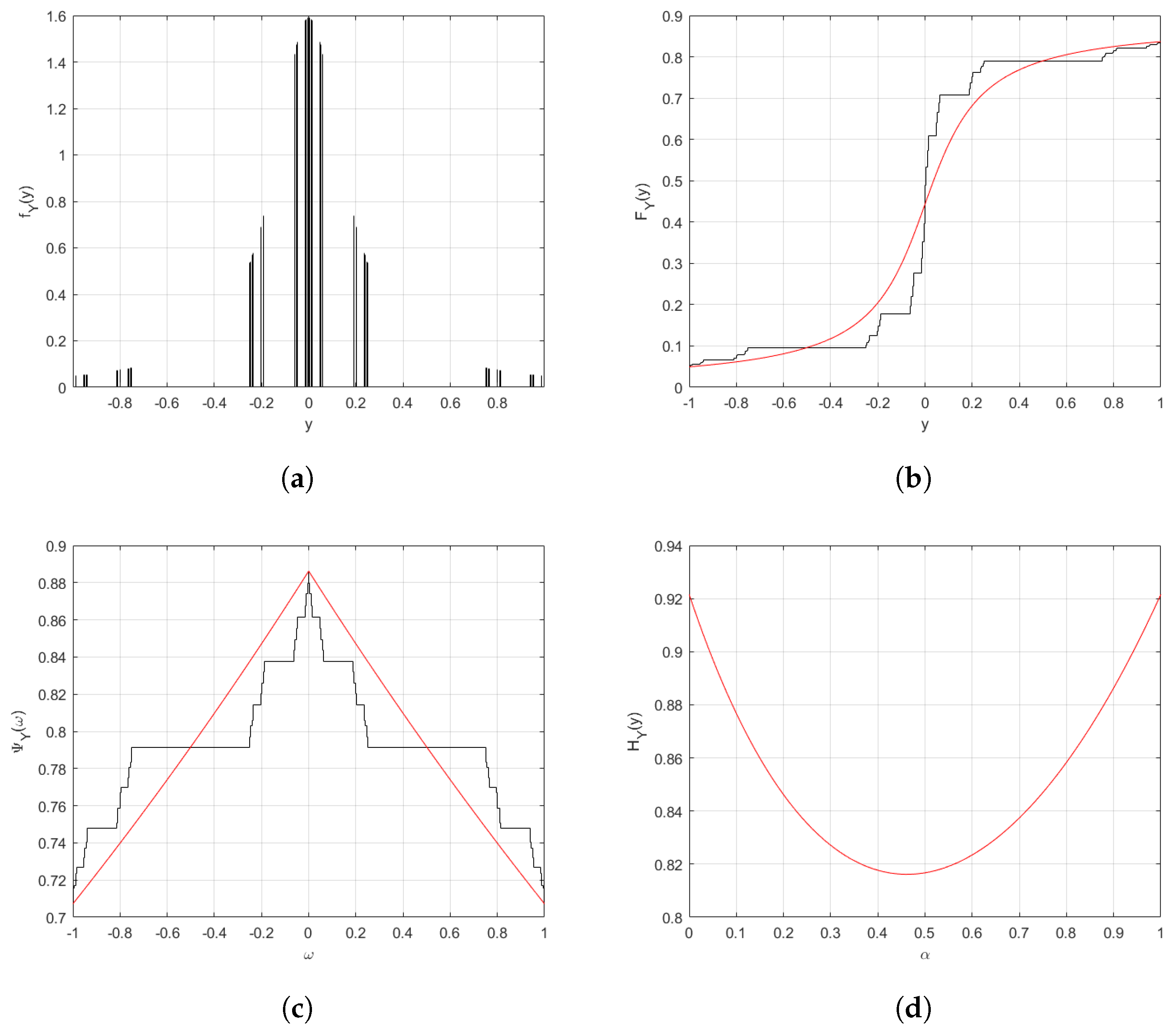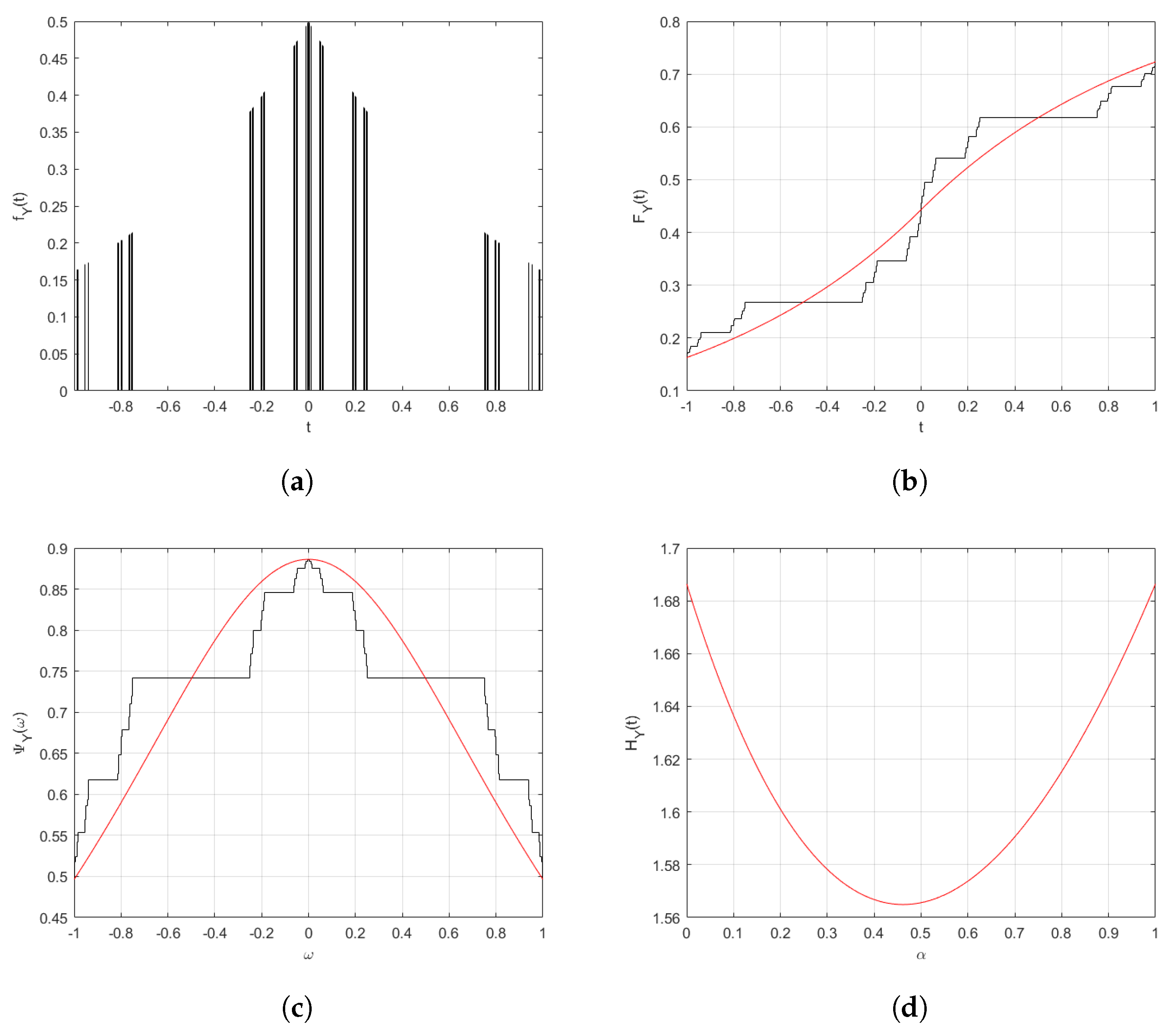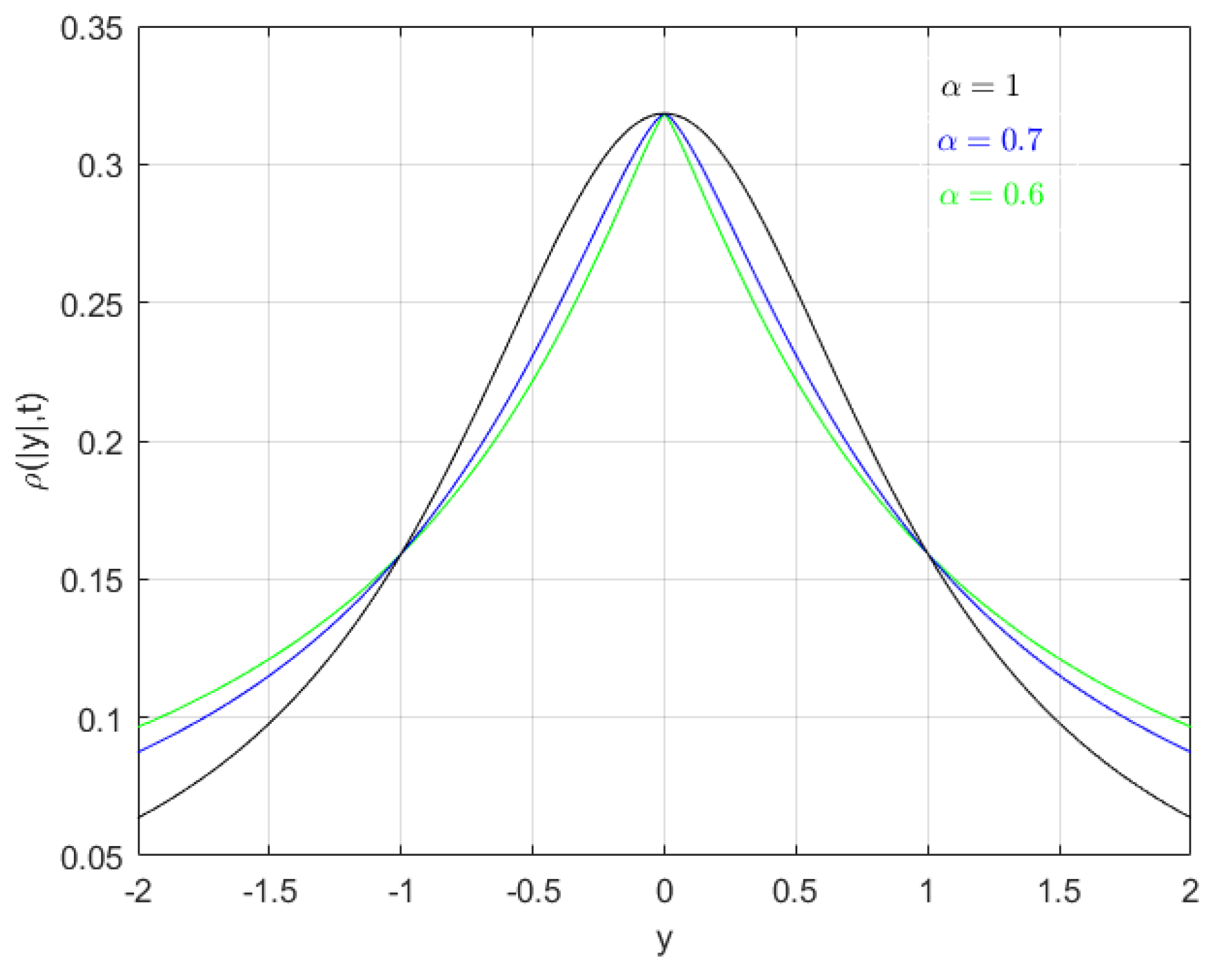Random Variables and Stable Distributions on Fractal Cantor Sets
Abstract
1. Introduction
2. Basic Tools and Prerequisites
- 1.
- Delete an open interval of length from the middle of .
- 2.
- Remove an open interval of length from the middle of each disjoint closed interval remaining after step 1.⋮
- k.
- Remove an open interval of length from the middle of each disjoint closed interval remaining after step .
3. Distributions on Thin Cantor-Like Sets
4. Hierarchy of Stable Distributions on Fractal Sets
- Gaussian stable distribution on fractal sets. In Equation (34) if we choose , and , then we haveThe asymptotic behavior of Equation (39) giveswhere and are the variance and mean respectively. The corresponding probability distribution function, which is the inverse Fourier transformation of Equation (39), is as follows:
- Cauchy stable distribution on fractal sets. If we choose , then Equation (34) givesThe corresponding probability distribution function is
5. Physical Models for Fractal Stable Distributions
6. Conclusions
Author Contributions
Funding
Conflicts of Interest
References
- Barnsley, M.F. Fractals Everywhere; Academic Press: Cambridge, MA, USA, 2014. [Google Scholar]
- Mandelbrot, B.B. The Fractal Geometry of Nature; WH Freeman: New York, NY, USA, 1983; Volume 173. [Google Scholar]
- Gazit, Y.; Berk, D.A.; Leunig, M.; Baxter, L.T.; Jain, R.K. Scale-invariant behavior and vascular network formation in normal and tumor tissue. Phys. Rev. Lett. 1995, 75, 2428–2431. [Google Scholar] [CrossRef] [PubMed]
- Baish, J.W.; Jain, R.K. Fractals and cancer. Cancer Res. 2000, 60, 3683–3688. [Google Scholar] [PubMed]
- Falconer, K. Techniques in Fractal Geometry; John Wiley and Sons: Hoboken, NJ, USA, 1997. [Google Scholar]
- Balankin, A.S. Effective degrees of freedom of a random walk on a fractal. Phys. Rev. E 2015, 92, 062146. [Google Scholar] [CrossRef] [PubMed]
- Zubair, M.; Mughal, M.J.; Naqvi, Q.A. Electromagnetic Fields and Waves in Fractional Dimensional Space; Springer: New York, NY, USA, 2012. [Google Scholar]
- Czachor, M. Waves along fractal coastlines: From fractal arithmetic to wave equations. Acta Phys. Pol. B 2019, 50, 813–831. [Google Scholar] [CrossRef]
- Chen, W.; Sun, H.-G.; Zhang, X.; Koroak, D. Anomalous diffusion modeling by fractal and fractional derivatives. Comput. Math. Appl. 2010, 59, 1754–1758. [Google Scholar] [CrossRef]
- Sandev, T.; Iomin, A.; Kantz, H. Anomalous diffusion on a fractal mesh. Phys. Rev. E 2017, 95, 052107. [Google Scholar] [CrossRef] [PubMed]
- Freiberg, U.; Zahle, M. Harmonic calculus on fractals-a measure geometric approach I. Potential Anal. 2002, 16, 265–277. [Google Scholar] [CrossRef]
- Barlow, M.T.; Perkins, E.A. Brownian motion on the Sierpinski gasket. Probab. Theory Relat. Fields 1988, 79, 543–623. [Google Scholar] [CrossRef]
- Kigami, J. Analysis on Fractals; Cambridge University Press: Cambridge, UK, 2001. [Google Scholar]
- Uchaikin, V.V. Fractional Derivatives for Physicists and Engineers; Springer: Berlin, Germany, 2013; Volume 1. [Google Scholar]
- Tatom, F.B. The relationship between fractional calculus and fractals. Fractals 1995, 3, 217–229. [Google Scholar] [CrossRef]
- Nigmatullin, R.R.; Le Mehaute, A. Is there geometrical/physical meaning of the fractional integral with complex exponent? J. Non Cryst. Solids 2005, 351, 2888–2899. [Google Scholar] [CrossRef]
- Cattani, C. Fractal and Fractional. Fractal Fract. 2017, 1, 1. [Google Scholar] [CrossRef]
- Herrmann, R. Fractional Calculus: An Introduction for Physicists; World Scientific Publishing: Singapore, 2014. [Google Scholar]
- Hilfer, R. Applications of Fractional Calculus in Physics; World Scientific Publishing Co.: Singapore, 2000. [Google Scholar]
- Kolwankar, K.M.; Gangal, A.D. Fractional differentiability of nowhere differentiable functions and dimensions. Chaos 1996, 6, 505–513. [Google Scholar] [CrossRef] [PubMed]
- Parvate, A.; Gangal, A.D. Calculus on fractal subsets of real-line I: Formulation. Fractals 2009, 17, 53–148. [Google Scholar] [CrossRef]
- Parvate, A.; Gangal, A.D. Calculus on fractal subsets of real-line II: Conjugacy with ordinary calculus. Fractals 2011, 19, 271–290. [Google Scholar] [CrossRef]
- Satin, S.; Parvate, A.; Gangal, A.D. Fokker–Planck equation on fractal curves. Chaos Solitons Fract. 2013, 52, 30–35. [Google Scholar] [CrossRef]
- Parvate, A.; Satin, S.; Gangal, A.D. Calculus on fractal curves in Rn. Fractals 2011, 19, 15–27. [Google Scholar] [CrossRef]
- Satin, S.; Gangal, A.D. Langevin Equation on Fractal Curves. Fractals 2016, 24, 1650028. [Google Scholar] [CrossRef]
- Golmankhaneh, A.K.; Fernandez, A.; Golmankhaneh, A.K.; Baleanu, D. Diffusion on middle-ξ Cantor sets. Entropy 2018, 20, 504. [Google Scholar] [CrossRef]
- Golmankhaneh, A.K.; Fernandez, A. Fractal Calculus of Functions on Cantor Tartan Spaces. Fractal Fract. 2018, 2, 30. [Google Scholar] [CrossRef]
- Golmankhaneh, A.K.; Baleanu, D. Diffraction from fractal grating Cantor sets. J. Mod. Opt. 2016, 63, 1364–1369. [Google Scholar] [CrossRef]
- Golmankhaneh, A.K. On the Fractal Langevin Equation. Fractal Fract. 2019, 3, 11. [Google Scholar] [CrossRef]
- Golmankhaneh, A.K. Statistical Mechanics Involving Fractal Temperature. Fractal Fract. 2019, 3, 20. [Google Scholar] [CrossRef]
- Jafari, F.K.; Asgari, M.S.; Pishkoo, A. The Fractal Calculus for Fractal Materials. Fractal Fract. 2019, 3, 8. [Google Scholar] [CrossRef]
- Golmankhaneh, A.K. On the calculus of the parameterized fractal curves. Turk. J. Phys. 2017, 41, 418–425. [Google Scholar] [CrossRef]
- Golmankhaneh, A.K. About Kepler’s Third Law on fractal-time spaces. Ain Shams Eng. J. 2018, 9, 2499–2502. [Google Scholar] [CrossRef]
- Golmankhaneh, A.K.; Balankin, A.S. Sub-and super-diffusion on Cantor sets: Beyond the paradox. Phys. Lett. A 2018, 382, 960–967. [Google Scholar] [CrossRef]
- Balankin, A.S.; Golmankhaneh, A.K.; Patiño-Ortiz, J.; Patiño-Ortiz, M. Noteworthy fractal features and transport properties of Cantor tartans. Phys. Lett. A 2018, 382, 1534–1539. [Google Scholar] [CrossRef]
- Golmankhaneh, A.K.; Baleanu, D. Non-local Integrals and Derivatives on Fractal Sets with Applications. Open Phys. 2016, 14, 542–548. [Google Scholar] [CrossRef]
- Shannon, C.E. A Mathematical Theory of Communication. Bell Syst. Tech. J. 1948, 27, 379–423. [Google Scholar] [CrossRef]
- Kapur, J.N. Measures of Information and Their Applications; Wiley: New York, NY, USA, 1994. [Google Scholar]
- Cattani, C. Fractional Calculus and Shannon Wavelet. Math. Probl. Eng. 2012, 2012, 26. [Google Scholar] [CrossRef]
- Cattani, C.; Pierro, G. On the fractal geometry of DNA by the binary image analysis. Bull. Math. Biol. 2013, 75, 1544–1570. [Google Scholar] [CrossRef] [PubMed]
- Heydari, M.H.; Hooshmandasl, M.R.; Ghaini, F.M.; Cattani, C. Wavelets method for solving fractional optimal control problems. Appl. Math. Comput. 2016, 286, 139–154. [Google Scholar] [CrossRef]
- DiMartino, R.; Urbina, W. On Cantor-like sets and Cantor-Lebesgue singular functions. arXiv 2014, arXiv:1403.6554. [Google Scholar]
- Cohen, S.N.; Elliott, R.J. Stochastic Calculus and Applications; Birkhäuser: New York, NY, USA, 2015; Volume 2. [Google Scholar]
- Papoulis, A.; Pillai, S.U. Probability, Random Variables, and Stochastic Processes, 4th ed.; McGraw-Hill: New York, NY, USA, 2002. [Google Scholar]
- Voit, J. The Statistical Mechanics of Financial Markets; Springer Science Business Media: Dodrecht, The Netherlands, 2005. [Google Scholar]
- Breiman, L. Probability, Volume 7 of Classics in Applied Mathematics; Society for Industrial and Applied Mathematics (SIAM): Philadelphia, PA, USA, 1992. [Google Scholar]
- Cizek, P.; Hardle, W.K.; Weron, R. Statistical Tools for Finance and Insurance; Springer Science Business Media: New York, NY, USA, 2005. [Google Scholar]
- Khantha, M.; Balakrishnan, V. First passage time distributions for finite one-dimensional random walks. Pramana 1983, 21, 111–122. [Google Scholar] [CrossRef]




© 2019 by the authors. Licensee MDPI, Basel, Switzerland. This article is an open access article distributed under the terms and conditions of the Creative Commons Attribution (CC BY) license (http://creativecommons.org/licenses/by/4.0/).
Share and Cite
Khalili Golmankhaneh, A.; Fernandez, A. Random Variables and Stable Distributions on Fractal Cantor Sets. Fractal Fract. 2019, 3, 31. https://doi.org/10.3390/fractalfract3020031
Khalili Golmankhaneh A, Fernandez A. Random Variables and Stable Distributions on Fractal Cantor Sets. Fractal and Fractional. 2019; 3(2):31. https://doi.org/10.3390/fractalfract3020031
Chicago/Turabian StyleKhalili Golmankhaneh, Alireza, and Arran Fernandez. 2019. "Random Variables and Stable Distributions on Fractal Cantor Sets" Fractal and Fractional 3, no. 2: 31. https://doi.org/10.3390/fractalfract3020031
APA StyleKhalili Golmankhaneh, A., & Fernandez, A. (2019). Random Variables and Stable Distributions on Fractal Cantor Sets. Fractal and Fractional, 3(2), 31. https://doi.org/10.3390/fractalfract3020031





